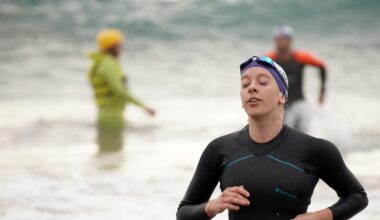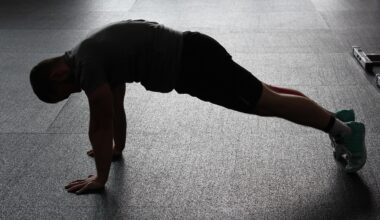Rowing Technique Drills for Beginners
Rowing is a demanding sport that requires proper technique for efficiency and performance. Beginners often struggle with coordination, timing, and strength in their strokes. Through focused drills, new rowers can develop essential skills that enhance their overall rowing experience. Firstly, understanding the basic rowing stroke is crucial. The stroke consists of four parts: catch, drive, finish, and recovery. Each part needs to be practiced separately to improve proficiency. Additionally, a strong emphasis should be placed on body positioning. An upright posture is essential for optimal leverage and energy distribution. Furthermore, focusing on hand positioning will help in properly distributing force through the oars. Every beginner should practice in a controlled environment, ideally in a stable rowing shell. Exercises can be conducted on land, such as using resistance bands to mimic rowing strokes. This method ensures that beginners can concentrate on muscle memory without water disruptions. Moreover, group sessions with experienced rowers can offer significant learning opportunities. Filming practice sessions can also provide valuable feedback, as it enables beginners to observe their techniques closely and make necessary adjustments.
Fundamental Drills for Improvement
One of the most effective drills for beginners is known as “rocker drill.” This drill emphasizes the importance of maintaining a balanced boat while practicing the rowing stroke. Typically, this involves rowing with just the blade of the oar submerged in the water while adjusting the body weight and maintaining proper posture. By focusing on balance, rowers develop a feel for the water, making them more stable during movements. Additionally, the “pause drill” enhances the understanding of each component in the stroke. Rowers pause briefly during the recovery phase, allowing them to focus on form and body alignment before the next stroke. Another vital drill is the “single-arm rowing drill.” Practicing with one arm engages the core and isolates muscle groups, allowing rowers to recognize and correct imbalances. Transitions from these drills into complete strokes allow the beginner to solidify their foundation. Remember, consistent practice will lead to gradual improvement. Furthermore, dedicating time to strength and conditioning off the water can enhance performance significantly. Exercises targeting the back, core, and legs are paramount in building overall rowing strength.
Listening to your coach’s advice is important when refining your rowing technique. Additionally, focus on breathing patterns. Breathing rhythmically ensures that rowers maintain steady energy levels throughout their sessions. It’s beneficial for beginners to engage in both individual and tandem rowing. Rowing with a partner allows for real-time feedback, making it easier to identify timing issues or stroke discrepancies. In essence, practicing drills alongside peers fosters a supportive environment for skill development. It’s also beneficial to incorporate interval training into your routine. Short bursts of intense activity followed by rest periods can improve cardiovascular fitness and strengthen rowing muscles. Adapting drills to different water conditions helps in developing adaptability. Meaningful progress often comes from challenging situations. Furthermore, beginners should prioritize monitoring their progress. Keeping a training log can highlight improvements over time, serving as motivation to continue refining technique. Engaging with rowing community members, whether online or in-person, boosts knowledge sharing and camaraderie. Utilizing modern technology, many apps exist to analyze performance, offering feedback tailored for beginners. These resources can make the learning process smoother and more enjoyable for every aspiring rower.
The Importance of Recovery
Effective recovery strategies shouldn’t be overlooked while practicing rowing techniques. After intensive training, muscles require time to heal and strengthen. Ensuring proper nutrition post-session is vital to restoration, as the body needs adequate protein and carbohydrates. A well-planned meal replenishes energy stores and aids muscle repair. In addition, hydration plays a significant role in recovery, particularly for athletes who spend long hours on the water. Drinking water during breaks helps maintain optimal performance levels. Furthermore, incorporating stretching exercises post-training assists in reducing muscle tightness and improving flexibility. Another crucial element is rest—allowing your body periods of rest prevents overuse injuries. Considering adequate sleep hours can work wonders in enhancing rowing performance. Participating in low-impact cross-training activities such as swimming or cycling can promote recovery without taxing rowing muscles heavily. Tuning into your body is essential; if aches persist, seek guidance from professionals to avoid potential injuries. Notably, practicing mindfulness, such as yoga or meditation, can aid in faster recovery while also focusing on mental resilience. Strong mental health supports the physical aspect of rowing and enhances overall well-being, making recovery an essential theme in rowing technique training.
Races can be an exhilarating experience for any rower, but beginners should be careful to gradually introduce themselves to competitive environments. Understanding pacing and race strategies can make a significant difference in performance. Engaging in sprint training can provide the necessary speed without compromising form. These sessions can help beginners adapt to the high demands of competitive rowing. Furthermore, analyzing race footage offers insights into position, timing, and competitor strategies. This practice can enhance preparation and boost confidence levels. Important to note is that while competition fosters growth, focusing on personal milestones remains crucial. Setting achievable goals keeps motivation high and directs attention towards one’s improvement. Moreover, participating in novice events can provide valuable experiences. Every race presents opportunities to learn from mistakes, improving techniques for future competitions. Rowers may also benefit from connecting with more experienced crew members before and after races. The shared knowledge in these interactions often leads to incredible insights and friendship. Always remember, rowing is a community sport, and valuable relationships can significantly enhance development. Embracing the camaraderie and support within the rowing community can positively influence a beginner’s journey.
Conclusion
In conclusion, it is vital to remember that mastering rowing techniques takes time, patience, and consistent effort. As a beginner, focusing on foundational drills allows for gradual skill acquisition. Emphasizing balance, timing, and strength will create a strong base for future enhancements. Joining a rowing club can provide structured training, access to coaches, and a community of passionate rowers. Consistent feedback is instrumental in refining techniques and fostering development. Additionally, staying mentally focused and maintaining a positive outlook greatly contributes to improvement as well. Never underestimate the value of community support in this journey. Interacting with fellow rowers will undoubtedly provide encouragement and motivation. As beginners continue to grow, each stroke brings them closer to becoming skilled rowers. Embrace challenges, and learn from experiences, whether on or off the water. Every row counts, and over time, those small improvements build up to significant progress. Lastly, maintain enthusiasm and a love for the sport, as this passion will drive your commitment to continuous learning. With diligence and dedication, every beginner can achieve their rowing goals, setting them up for a memorable journey ahead.
Rowing is a captivating activity that promotes fitness and teamwork. Beginners often face challenges in developing proper technique, which is essential for effective rowing. Drills are an ideal solution for mastering the art of rowing and can be approached progressively. As novice rowers embark on their journey, consistency plays a crucial role. A deliberate focus on using drills helps in establishing a strong foundation that leads to noticeable improvement over time. It’s essential to concentrate on striking a balance between practice and theory. Understanding the mechanics behind each stroke makes it easier to implement techniques on the water. Additionally, beginners should engage with coaches or seasoned rowers regularly for guidance and pointers. This interaction fosters a professional environment that encourages learning and improvement. Moreover, technology can enhance training experiences through various rowing apps and video analyses, which provide instant feedback. Aligning passion and dedication with proper techniques will result in mastering the basics of rowing swiftly. Equally important is maintaining well-rounded related fitness through cross-training. Activities like strength training, cycling, or swimming can aid overall performance, so embedding these into a training schedule can be beneficial.
Rowing is a highly competitive sport that provides rigorous physical challenges, and for many beginners, mastering the essential techniques is vital for success. It’s important to remind yourself that improvement comes with persistence; therefore, developing a structured practice schedule is advisable. Firstly, beginners should concentrate on maintaining proper posture, which is critical for efficient strokes. Athletes should also focus on synchronized movement—ideal for races— with teammates to maximize speed and power. Practicing on stationary rowing machines can enhance technique without the unpredictability of water conditions. Specific drills can build muscle memory, essential for seamless transitions during races. For beginners, learning from others is invaluable; watching experienced rowers can highlight effective movements and strategies. Secondly, regular assessments of your technique through video reviews help identify areas needing improvement. This visual feedback is instrumental in revealing often-unnoticed flaws. Therefore, regular communication with your coach regarding your progress is essential. Finally, staying motivated can be enhanced by setting incremental goals and celebrating achievements. Each small win—whether mastering a technique or completing a challenging workout—reinforces commitment and nurtures growth. Ultimately, dedication and continuous learning are at the core of rowing success.


